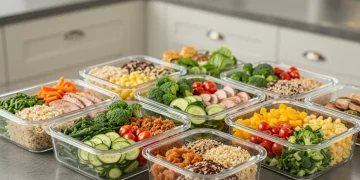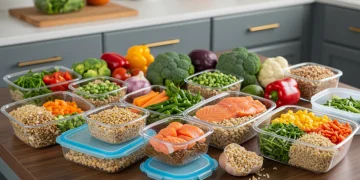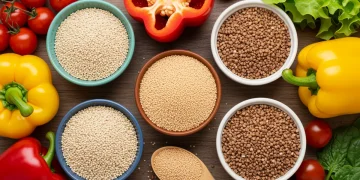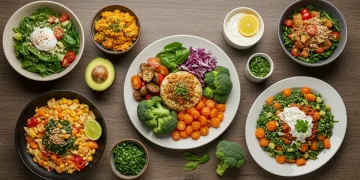Healthy Work Week Lunches 2025: 5 Make-Ahead Recipes

Achieve a healthier work week in 2025 with five innovative, make-ahead lunch recipes designed to save you three hours of valuable prep time each week, ensuring delicious and nutritious meals are always at hand.
Preparing healthy lunches for the work week in 2025 can often feel like an insurmountable task, especially when juggling demanding schedules. The daily scramble to pack something nutritious can lead to unhealthy choices or last-minute, expensive takeout. Imagine reclaiming three hours of your precious week, all while ensuring your midday meals are both delicious and beneficial for your well-being. This guide offers practical solutions to transform your lunch routine, making healthy eating an effortless part of your busy life.
The undeniable benefits of make-ahead meals
Embracing the concept of make-ahead meals extends far beyond mere convenience. It’s a strategic approach to health and productivity, allowing you to sidestep common pitfalls associated with spontaneous food choices. By dedicating a small amount of time to preparation, you unlock a cascade of advantages that benefit your body, your wallet, and your peace of mind.
One of the most significant benefits is the enhanced nutritional control. When you prepare your own meals, you have complete oversight of the ingredients. This means you can actively choose fresh, whole foods, control portion sizes, and limit unhealthy additives like excessive sodium, sugar, and unhealthy fats often found in processed or restaurant meals. This level of control is crucial for managing weight, boosting energy levels, and supporting overall health. It empowers you to tailor your diet to your specific needs, whether you’re focusing on protein intake, fiber, or reducing allergens.
financial savings and time efficiency
Beyond nutrition, make-ahead meals are a financial game-changer. The cost of eating out, even for seemingly modest lunches, accumulates rapidly over a week or month. Bringing your own lunch consistently can save hundreds of dollars annually, funds that can be redirected towards other goals or simply enjoyed. The initial investment in groceries for meal prepping is often significantly less than the cumulative cost of daily restaurant visits or delivery services. It’s a simple economic truth that cooking at home is almost always cheaper.
- Reduced grocery waste due to planned ingredient usage.
- Elimination of impulse purchases from convenience stores.
- Fewer expenses on transportation for lunch runs.
- Better budgeting for food expenditures overall.
The time efficiency is equally compelling. While the initial prep session might take an hour or two, it consolidates the daily decision-making and cooking into one focused effort. This frees up your lunch break for actual relaxation, exercise, or tackling personal tasks, rather than waiting in line or preparing food. Imagine having your lunch ready to grab and go every morning, eliminating that stressful rush. This streamlined process also reduces mental fatigue, as you’re not constantly thinking about what to eat next.
Overall, make-ahead meals provide a holistic solution to modern-day eating challenges. They offer a pathway to improved health, financial prudence, and a more organized, less stressful daily routine. The small effort invested upfront yields substantial returns throughout the week, making it an invaluable habit for anyone seeking a more balanced lifestyle.
Mediterranean quinoa bowls: a taste of the sun
The Mediterranean Quinoa Bowl is a vibrant, flavorful, and incredibly nutritious option that perfectly embodies the spirit of healthy eating. Packed with protein, fiber, and an array of vitamins, it’s a meal that satisfies both hunger and taste buds. This recipe draws inspiration from the Mediterranean diet, renowned for its health benefits and delicious, fresh ingredients. It’s also remarkably versatile, allowing for endless customization based on your preferences and what’s in season.
To begin, the foundation of this bowl is quinoa, a complete protein that provides sustained energy. Cooking a larger batch of quinoa at the start of the week saves significant time. Pair this with roasted chickpeas, which add a delightful crunch and extra plant-based protein. Tossing chickpeas with a little olive oil, smoked paprika, and cumin before roasting transforms them into crispy, savory nuggets that are perfect for meal prep, as they hold up well for several days.
assembling your vibrant bowls
The beauty of the Mediterranean Quinoa Bowl lies in its fresh components. Incorporate a generous serving of chopped cucumber, cherry tomatoes, and bell peppers for hydration and a burst of vitamins. Kalamata olives provide a briny depth, while crumbled feta cheese adds a creamy, tangy element. For greens, spinach or mixed greens work wonderfully, adding a fresh contrast to the other ingredients. These components can be prepped and stored separately, then combined just before eating to maintain freshness.
- Cooked quinoa (1 cup dry yields 3 cups cooked).
- Roasted chickpeas (1 can, rinsed and dried).
- Chopped cucumber, cherry tomatoes, and bell peppers.
- Kalamata olives and crumbled feta cheese.
The dressing is equally important and can be prepared in advance. A simple lemon-herb vinaigrette, made with extra virgin olive oil, fresh lemon juice, dried oregano, a touch of garlic, and salt and pepper, brings all the flavors together beautifully. Store the dressing in a separate small container and add it right before serving to prevent the other ingredients from getting soggy. This careful layering ensures that each component retains its texture and flavor, making every bite a delightful experience.
This Mediterranean Quinoa Bowl is not just a meal; it’s a celebration of fresh, wholesome ingredients. It’s easy to prepare in bulk, stores well, and offers a delicious and balanced lunch that will keep you energized and satisfied throughout your workday. Its versatility means you can easily swap ingredients to keep things interesting, ensuring you never get tired of this healthy staple.
Spicy peanut noodle jars: layers of flavor
Spicy Peanut Noodle Jars offer an ingenious solution for meal prepping, combining convenience with an explosion of flavor. These layered jars are not only visually appealing but also incredibly practical, allowing you to prepare several days’ worth of lunches in one go. The key is in the layering, which keeps the ingredients fresh and prevents the noodles from becoming soggy until you’re ready to eat. This recipe is a fantastic way to enjoy a restaurant-quality meal at your desk, without the fuss or cost.
The base of the flavor comes from a rich and spicy peanut sauce. This sauce can be made in a larger batch and stored in the refrigerator. It typically includes peanut butter, soy sauce, rice vinegar, a touch of maple syrup or honey, sesame oil, ginger, garlic, and chili garlic sauce for that desirable kick. Adjust the spice level to your preference. This sauce is robust enough to coat the noodles and vegetables, infusing every bite with its distinctive taste.
strategic layering for freshness
The magic of the noodle jar lies in its construction. The dressing goes at the very bottom of the jar. This prevents it from soaking into the noodles and vegetables prematurely. Next, layer in heartier, less absorbent vegetables such as shredded carrots, bell peppers, and edamame. These can withstand sitting in the dressing without becoming mushy. Following these, add your cooked noodles. Soba noodles, rice noodles, or even whole wheat spaghetti work well. Ensure the noodles are cooled completely before adding them to the jar.
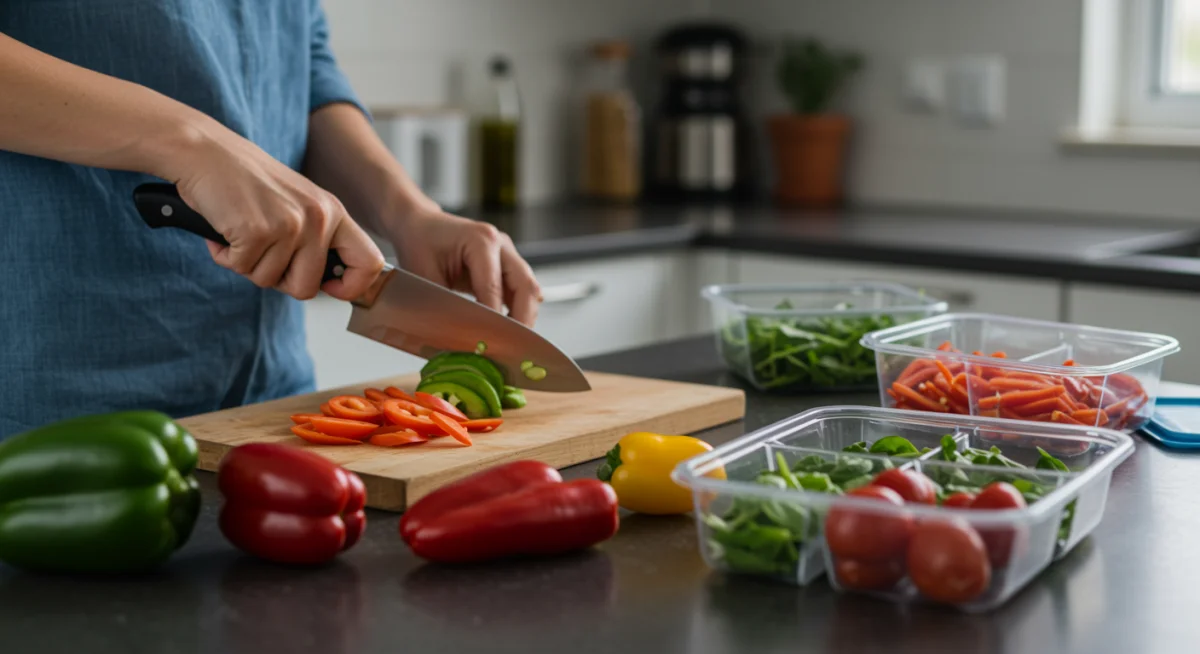
For the top layers, include tender greens like spinach or shredded cabbage, and a protein source. Cooked chicken, shrimp, or baked tofu are excellent choices, providing a substantial addition to the meal. Garnish with chopped peanuts and fresh cilantro for added texture and aroma. When it’s time to eat, simply shake the jar to distribute the dressing, or empty the contents into a bowl and mix. The result is a perfectly dressed, fresh, and flavorful noodle salad.
- Peanut sauce at the bottom.
- Hard vegetables (carrots, bell peppers, edamame).
- Cooked and cooled noodles.
- Tender greens and protein (chicken, tofu).
Spicy Peanut Noodle Jars are a testament to how creative meal prep can be. They offer a delicious, convenient, and healthy lunch option that’s far more exciting than a traditional sandwich. The ability to customize ingredients means you can enjoy a different flavor profile each week, making healthy eating an adventure rather than a chore.
Sheet pan chicken and veggie prep: minimal cleanup
The sheet pan method has revolutionized weeknight dinners and is equally effective for preparing healthy work week lunches. This approach minimizes cleanup and maximizes flavor, making it an ideal strategy for those looking to streamline their meal prep process. By roasting protein and vegetables together on a single sheet pan, you infuse them with delicious savory notes, creating a balanced and satisfying meal with very little effort.
The beauty of sheet pan meals lies in their simplicity and versatility. Choose your favorite protein – chicken breast or thighs, salmon fillets, or even firm tofu – and complement it with a colorful array of vegetables. Broccoli florets, bell peppers, zucchini, sweet potatoes, and red onion are all excellent choices that roast beautifully. The key is to cut all ingredients to roughly the same size to ensure even cooking, preventing some items from burning while others remain undercooked.
flavorful seasonings and optimal roasting
Seasoning is paramount for a delicious sheet pan meal. A simple blend of olive oil, garlic powder, onion powder, dried herbs like oregano or thyme, salt, and pepper works wonders. For an extra kick, consider adding smoked paprika, chili powder, or a squeeze of fresh lemon juice before roasting. Toss all the ingredients directly on the sheet pan, ensuring everything is evenly coated. This hands-on approach ensures every piece gets its share of flavor.
- Cut vegetables and protein into uniform pieces.
- Use a generous amount of olive oil for even roasting.
- Don’t overcrowd the pan to ensure proper browning.
- Roast at a high temperature (400-425°F) for optimal texture.
Roast the mixture in a preheated oven until the protein is cooked through and the vegetables are tender-crisp and slightly caramelized. Once cooled, divide the chicken and vegetables into individual meal prep containers. These portions can be easily reheated in the microwave for a quick and nutritious lunch. The minimal cleanup involved – often just one sheet pan to wash – makes this method incredibly appealing for busy individuals.
Sheet Pan Chicken and Veggie Prep is a testament to efficient cooking that doesn’t compromise on taste or nutrition. It’s a straightforward, delicious, and healthy option for your work week lunches, offering a hearty meal that’s packed with essential nutrients and flavor, all while keeping your kitchen duties to a minimum.
Mason jar salads: fresh and customizable
Mason jar salads are a game-changer for anyone seeking fresh, crisp, and customizable lunches throughout the work week. The unique layering technique of a Mason jar salad keeps ingredients separate and vibrant until you’re ready to eat, preventing sogginess and ensuring a delightful texture with every bite. This method is not just practical; it also allows for endless creativity in combining flavors and textures, making healthy eating exciting.
The secret to a successful Mason jar salad lies in the order of ingredients. Always start with the dressing at the very bottom. This acts as a barrier, protecting the more delicate ingredients from becoming saturated. A vinaigrette is ideal, but creamy dressings can also work if kept to a moderate amount. Following the dressing, layer in hard, non-absorbent vegetables like cherry tomatoes, cucumbers, bell peppers, and carrots. These can sit in the dressing without wilting and will help keep the upper layers fresh.
building your perfect layered salad
Next, add your grains or proteins. Cooked quinoa, couscous, pasta, or even lentils provide a substantial base and help make the salad more filling. For protein, consider grilled chicken, chickpeas, black beans, or hard-boiled eggs. These ingredients add essential nutrients and keep you satisfied for longer. Ensure they are cooled before adding them to the jar to maintain freshness and prevent condensation.
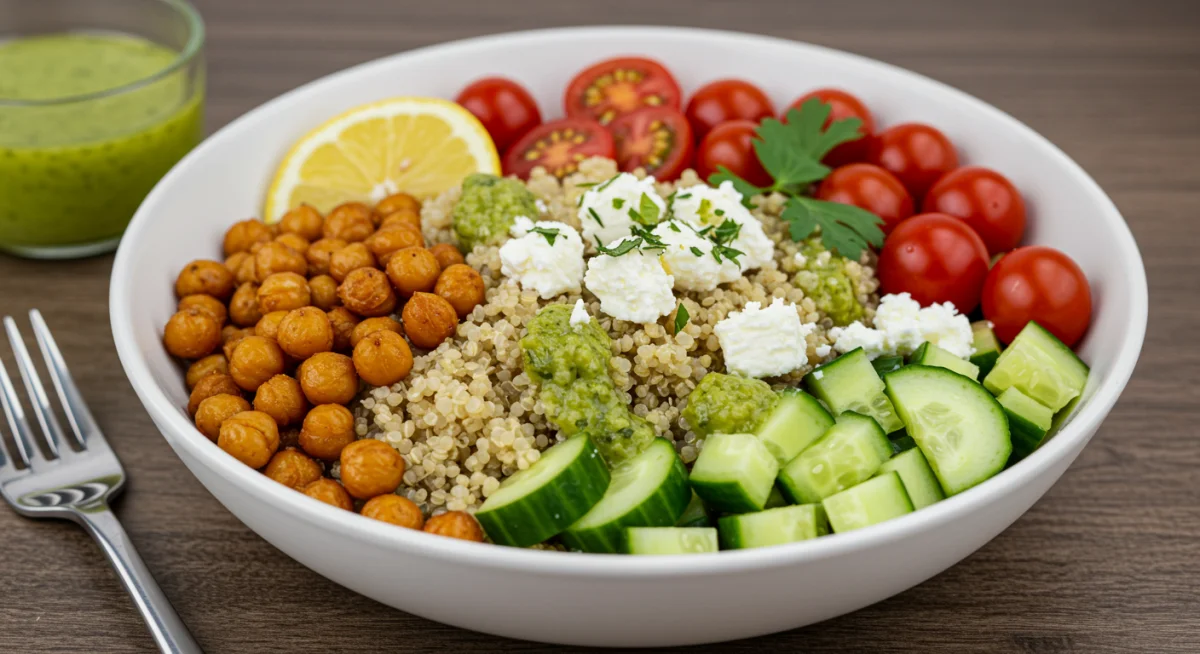
The top layers are reserved for the most delicate ingredients. Soft cheeses like feta or goat cheese, nuts, seeds, and dried fruits can be added here. Finally, fill the jar to the brim with your chosen leafy greens – spinach, mixed greens, or chopped romaine. Packing the greens tightly helps to keep them fresh and prevents them from bruising. When it’s time to eat, simply invert the jar into a bowl, and the dressing will cascade over all the ingredients, creating a perfectly dressed salad.
- Dressing at the bottom to prevent sogginess.
- Hard vegetables next, acting as a barrier.
- Grains and proteins in the middle.
- Delicate greens and toppings at the top.
Mason jar salads are a testament to how easy and enjoyable healthy meal prep can be. They offer a visually appealing, convenient, and incredibly fresh lunch option that can be customized to suit any dietary preference or craving. With a little planning, you can have a week’s worth of vibrant, delicious salads ready to go, making healthy choices effortless.
Savory egg muffins: portable protein power
Savory egg muffins are an absolute powerhouse for healthy work week lunches, offering a convenient, protein-packed, and highly customizable option. These individual portions are essentially mini frittatas, baked in muffin tins, making them perfectly portable and ideal for grab-and-go meals. They are incredibly versatile, allowing you to incorporate a variety of vegetables and cheeses, ensuring you never get bored with your healthy routine. This recipe is a fantastic way to utilize leftover vegetables and ensure a nutritious start or midday boost.
The core of savory egg muffins is, of course, eggs, which provide a complete protein source essential for muscle repair and sustained energy. To prepare, simply whisk eggs with a splash of milk or cream, and season with salt and pepper. The real fun begins with the add-ins. Consider a medley of finely diced bell peppers, spinach, onions, mushrooms, or even cooked sausage or bacon bits for extra flavor. The smaller you chop your vegetables, the better they will distribute throughout the muffins.
baking and customizing your muffins
Before pouring the egg mixture, lightly grease your muffin tin or use paper liners. Distribute your chosen fillings evenly among the muffin cups. This could include a handful of spinach at the bottom, followed by some diced ham and a sprinkle of shredded cheese. Then, pour the whisked egg mixture over the fillings, filling each cup about two-thirds full. Be mindful not to overfill, as the eggs will puff up slightly during baking.
- Whisk eggs with milk and seasonings.
- Chop vegetables finely for even distribution.
- Grease muffin tins or use liners.
- Bake until set and lightly golden.
Bake the egg muffins in a preheated oven until they are set in the center and lightly golden brown on top. Once cooled, they can be stored in an airtight container in the refrigerator for up to 4-5 days. They are delicious served cold, at room temperature, or gently reheated in the microwave. Their versatility makes them suitable not just for lunch, but also as a quick breakfast or a healthy snack.
Savory egg muffins truly exemplify efficient and healthy meal prep. They are easy to make in bulk, store beautifully, and provide a customizable, protein-rich option that keeps you feeling satisfied and energized throughout your busy work week. With this recipe, you’ll have a delicious and nutritious meal ready whenever hunger strikes, making healthy eating simple and enjoyable.
Streamlining your meal prep process for success
Successfully integrating make-ahead meals into your routine requires more than just good recipes; it demands an efficient and sustainable meal prep process. Streamlining your approach can turn what might seem like a daunting task into an enjoyable and rewarding weekly ritual. The goal is to minimize effort while maximizing output, ensuring you have healthy, delicious meals ready to go without feeling overwhelmed.
Start by dedicating a specific time each week for meal prep. For many, this is Sunday afternoons, but choose a time that best fits your schedule and energy levels. During this dedicated slot, focus on batch cooking staple ingredients like grains (quinoa, brown rice), roasting vegetables, and cooking proteins. Having these components ready allows for quick assembly of various meals throughout the week, reducing daily cooking time significantly.
essential tools and smart strategies
Having the right tools can make a world of difference. Invest in good quality, airtight meal prep containers that are microwave-safe and stackable. Glass containers are excellent as they don’t absorb odors or stains and are durable. A sharp knife, a large cutting board, and a few sheet pans will also greatly enhance your efficiency. These investments will pay off in saved time and convenience.
- Choose a dedicated meal prep day.
- Batch cook grains, proteins, and vegetables.
- Invest in quality airtight containers.
- Utilize kitchen tools that save time.
Beyond tools, strategic planning is key. Create a weekly meal plan that incorporates your chosen make-ahead recipes. This plan helps you create a concise grocery list, preventing unnecessary purchases and food waste. When cooking, aim for recipes that share common ingredients or cooking methods to further consolidate your efforts. For example, if one recipe calls for roasted bell peppers, consider how you can incorporate them into another dish.
Finally, don’t be afraid to experiment and adapt. Your meal prep routine should evolve with your preferences and schedule. If a recipe isn’t working for you, try a new one. If you find yourself short on time one week, opt for simpler, quicker prep options. The key is consistency and finding a rhythm that works for your unique lifestyle. By streamlining your meal prep, you’re not just preparing food; you’re investing in your health, time, and peace of mind.
| Key Aspect | Brief Description |
|---|---|
| Time Savings | Save up to 3 hours weekly by preparing meals in advance, consolidating cooking efforts. |
| Nutritional Control | Gain full oversight of ingredients, portion sizes, and nutrient content for healthier choices. |
| Financial Benefits | Significantly reduce daily food expenses by avoiding takeout and restaurant meals. |
| Recipe Variety | Explore 5 diverse make-ahead recipes like quinoa bowls and noodle jars to keep meals exciting. |
Frequently asked questions about healthy lunch prep
Most make-ahead lunches, when stored properly in airtight containers in the refrigerator, can stay fresh for 3 to 5 days. Ingredients like leafy greens might need to be added closer to consumption for optimal crispness. Proper cooling before storage is key to extending shelf life.
Airtight glass containers are highly recommended for meal prepping. They are durable, microwave-safe, oven-safe, and don’t absorb odors or stains. Look for containers with separate compartments if you prefer to keep certain ingredients isolated until mealtime for better texture.
Some components, like cooked grains, roasted chicken, or egg muffins, freeze well. However, fresh vegetables and delicate greens are generally not suitable for freezing as they can become mushy upon thawing. It’s best to freeze individual components and assemble fresh when ready.
To prevent soggy salads, always put the dressing at the bottom of the container, followed by hard vegetables. Delicate greens should be placed on top. For Mason jar salads, this layering technique is crucial. Only mix the salad right before you are ready to eat it.
Start small, perhaps by prepping just 2-3 lunches initially. Choose simple recipes you enjoy. Invest in good containers and dedicate a specific time each week. Don’t be afraid to reuse ingredients across different meals to maximize efficiency and minimize waste.
Conclusion
Embracing the strategy of preparing healthy lunches for the work week in 2025 is more than just a culinary trend; it’s a lifestyle upgrade that promises significant returns in health, time, and financial well-being. By utilizing these five make-ahead recipes, you can effortlessly save three hours of prep time each week, ensuring a consistent supply of delicious, nutritious meals. This approach not only frees up valuable time but also empowers you to make informed food choices, reducing reliance on less healthy, spontaneous options. The journey to a more organized and health-conscious routine begins with a single step: planning your meals in advance. As you integrate these practical recipes and strategies, you’ll discover the profound impact that mindful meal preparation can have on your overall quality of life, fostering sustained energy and a greater sense of control over your daily nutrition.
